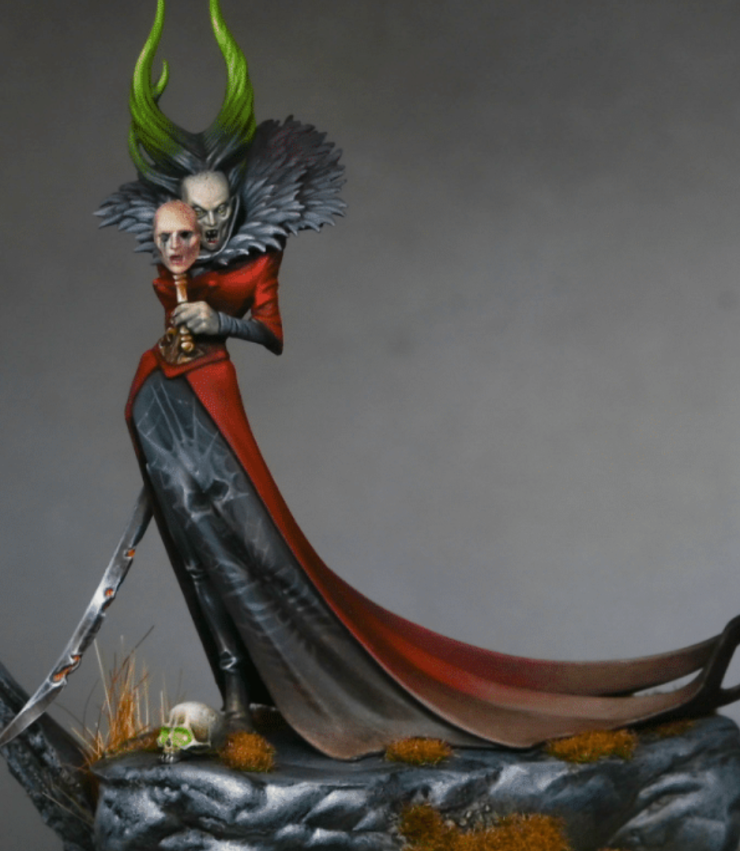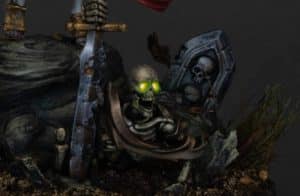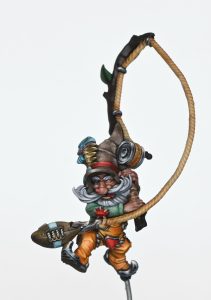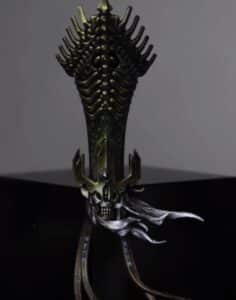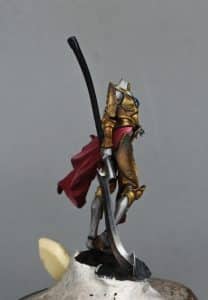Lady Annika’s thirst for blood is legendary, even amongst the Soulblight vampires! I really enjoyed painting her and made a few tweaks to the model.
Here is a series of videos I created for how to paint Lady Annika, scroll down to explore them in order, or use the contents below to quickly jump to to a part of Lady Annika, The Thirsting Blade!
Video: How to Paint Lady Annika Face and Hair
This is the first video in a series of how to paint Lady Annika.
This video looks at painting the face and hair to display level.
Materials Needed for her Face and Hair
- Games Workshop Paints: Kislev Flesh, Dark Reaper, Ushabti Bone, Flayed One Flesh, Moot Green, Yriel Yellow
- Vallejo Paints: Black, Basalt Grey, Dark Sea Grey
- P3 Paint: Morrow White
- Fine detail brushes
- Wet palette
- Water (for thinning paints)
Preparation
- Prime and Prepare: Prime the whole model and build it, leaving the head separate for easier painting. This approach allows better access to the head, especially around areas obstructed by accessories like masks.
Painting the Skin
- Base Coat with Kislev Flesh: Thin Kislev Flesh with water at a ratio of approximately 2:1 (water:paint). Apply the thinned paint to the head, aiming for a very translucent effect. This will take around 3-4 layers to achieve a good, but not opaque, coverage.
- Shading: Mix Kislev Flesh with Dark Reaper to create various shades for skin shadows. Start with a small amount of Dark Reaper to slightly darken the Kislev Flesh and incrementally increase the amount of Dark Reaper for deeper shadows. Apply these mixes carefully to areas like under the eyes, around the nose, and under the chin to simulate natural shadows.
- Adding Depth with Ushabti Bone and Flayed One Flesh: Introduce Ushabti Bone and Flayed One Flesh for highlights and to add depth to the skin. These should also be thinned and applied sparingly to areas that would naturally catch the light.
- Refining Details: Use pure Dark Reaper to define the eyes and deeper shadows. Then, carefully increase the intensity of highlights and shadows by adding more layers, paying close attention to the light source (coming from the left in this case) to ensure a realistic appearance.
Painting the Hair
- Base with Moot Green: Apply Moot Green as the base colour for the hair. If necessary, mix Moot Green with a little black to adjust the shade. Ensure to cover all strands, aiming for a uniform base layer.
- Add Highlights and Shadows: Create a gradient effect by mixing Moot Green with white for highlights and pure black for deeper shadows. Apply these mixes strategically to mimic natural hair highlights and to give the impression of volume and movement.
- Detailing with Fine Strands: Use a fine brush to add delicate strands of hair in lighter green shades towards the tips and darker shades near the roots to simulate depth and texture.
- Roots Detailing: For an added touch of realism, use Basalt Grey and Dark Sea Grey near the roots to suggest regrowth or a transition of colour. This technique adds complexity and depth to the hair.
Finishing Touches
- Glazing for Smoothness: Once satisfied with the skin and hair, use glazing techniques to smooth out transitions and blend the colours more seamlessly. This step involves thin layers of paint applied over dry areas to subtly adjust tones and shades.
- Eyes and Teeth: Paint the eyes using Yriel Yellow for the whites and Vallejo Black for the pupils. For the teeth, use Ushabti Bone for a natural look, and carefully define each tooth for clarity.
- Lips: Paint the lower lip with a mixture of red (e.g., Mephiston Red from Games Workshop) and add highlights with a mix of Shabti Bone and the red base colour to create a natural gradient.
Video: How to Paint Lady Annikas Mask of Horror
This video shows how to paint the mask (and some of the difficulties I had!) for Lady Annika.
Materials Needed
- Games Workshop Paints: Cadian Fleshtone, Rhinox Hide, Ushabti Bone, Mephiston Red, Dark Reaper (later changed to Corvus Black)
- Vallejo Paint: Model Color Air White
- Fine detail brushes
- Wet palette
- Water (for thinning paints)
Base Coat
- Prime the Mask: Begin with a black primer to ensure the colours that follow stand out.
- Apply Cadian Fleshtone: Cover the mask with Cadian Fleshtone. This will likely take three to four coats due to the poor coverage over the black primer. The aim is to achieve a base that resembles a realistic skin tone, though the mask itself is quite small, making this task more challenging.
Creating the Skin Tones
- Mix Shades: Prepare a range of shades on your wet palette by mixing Cadian Fleshtone with varying amounts of white for highlights and Rhinox Hide for shadows. For deeper shadows, use a 50/50 mix of Cadian Fleshtone and Rhinox Hide, and for pure shadow areas, use Rhinox Hide alone.
- Block in Highlights and Shadows: Considering the light source is from the top left, start blocking in highlights and shadows to define the mask’s features. This initial stage doesn’t require perfect blending, as the translucent nature of the watered-down paints (approximately two parts water to one part paint) allows for underlying layers to show through, contributing to a more natural look.
Refining Details
- Enhance the Highlights: Use the lighter mixes (Cadian Fleshtone with white and Ushabti Bone with white) to highlight areas like the bridge of the nose, cheekbones, and forehead. These areas may need even more watered-down paint to avoid a chalky texture.
- Detailing the Eyes and Mouth: With Corvus Black, add definition around the eyes and mouth. Initially, Dark Reaper was used, but Corvus Black provided a more suitable shade for creating a horror effect without being overly saturated.
Adding Horror Elements
- Mascara Tears: Using Corvus Black, paint streaks running down from the eyes to simulate mascara tears, ensuring they thin out towards the bottom. This effect should look distressed and slightly uneven to enhance the horror aesthetic.
- Red Lips: Paint the lips with Mephiston Red, carefully defining them to stand out against the paler skin tones. The open mouth adds to the mask’s gormless, horrific expression.
Finishing Touches
- Softening and Blending: Go back over the mask to soften any harsh lines or transitions, especially around the streaks and shadowed areas, to ensure a coherent and lifelike (yet horrific) appearance.
- Detailing and Corrections: If necessary, use the skin tone mixes to correct any mistakes or overly bold lines, particularly around the eyes and eyebrows, to maintain the desired look.
Video: How to Paint Lady Annikas Dress
These videos show how to paint Lady Annikas dress, from the distinctive vivid reds to the freehand pattern on her skirts. I decided I didn’t like the freehand after all and changed it to something else (that video is a little further down!)
Materials Needed for Lady Annikas Vampire Red Dress
- Games Workshop Paints: Mephiston Red, Evil Sunz Scarlet
- Vallejo Paint: Model Color Black (or any black paint you prefer)
- Fine detail brushes
- Wet palette
- Water for thinning paints
Step by Step Guide to Lady Annikas Vampire Red Dress
Create a Gradient of Reds: On your wet palette, start with pure Mephiston Red. Then create four additional shades by progressively adding Vallejo Model Color Black to Mephiston Red. You should have a range from pure Mephiston Red to a dark, almost brownish red. The exact proportions aren’t crucial, but aim for a gradual transition from light to dark across the five mixes.
Apply a Dark Red Base: Select one of the darker red mixes (close to a 50/50 mix of Mephiston Red and black) and cover the entire dress. This base layer sets a foundation for building up the red tones and ensures that the shadows aren’t too stark or black.
Begin with Mid-tones: Starting with the second or third darkest shade, begin to layer up the colour, focusing on areas that would naturally catch the light. Keep your paints thinned (approximately 1.5 parts water to 1 part paint) to ensure smooth transitions.
Add Highlights: Gradually work your way up through the shades, ending with pure Mephiston Red for the brightest highlights. Focus these on the highest points of the dress, where light would naturally hit the most. This includes the tops of folds and the hip area.
Smooth Out Transitions: Unlike non-metallic metal (NMM) techniques, which require stark contrasts, velvet demands soft, gradual transitions. Achieve this by applying multiple thin layers, allowing each to dry before applying the next. This method ensures a soft, velvety texture.
Bright Highlights: To add vibrancy, sparingly apply Evil Sunz Scarlet to the very highest points and sharpest creases of the dress. Be cautious with this bright, slightly orange shade, as overuse can detract from the deep red velvet effect. Focus on areas like creases on the arm and the upper parts of the dress.
Detailing: Use the darker red mixes to deepen shadows or adjust transitions where necessary. If you’ve already painted adjacent areas (such as hands or accessories), be extra cautious to avoid splattering these with red.
Modifying Your Brush: For fine detail work, consider customising your brush by trimming it to create a longer, thinner tip. This can provide more control for painting fine details and maintaining thin, even coats.
Video: How to Paint Lady Annikas Dress Freehand (First Version)
This is the first version of the skirt freehand I did for Lady Annika. Although this attempt was ultimately not to my liking, so I started afresh, the process and techniques described here may be useful for anyone looking to add intricate details to miniature models. This step-by-step guide incorporates a gothic vine pattern.
Materials and Tools Used
- Paints: Vallejo German Grey, Neutral Grey, Black, and Dark Sea Grey; Games Workshop Corvus Black, Pelgrave Blue, and Blue Horror.
- Brushes: Fine detail brushes suitable for precise freehand work.
- Palette: A wet palette to keep your paints workable.
- Water: For thinning your paints.
Step by Step on How to Paint Lady Annikas Dress Freehand (First Version)
Basecoat the Dress: Begin with a black primer as a solid foundation for your paints. This tutorial focuses on the inner dress section or skirt of Lady Annika.
Block in Highlights and Shadows: Use a mix of German Grey and Neutral Grey to block in the highlights on the dress, focusing on areas that would naturally catch the light. Add shadows with a blend of Neutral Grey and Black to create depth. This foundational work is crucial for the subsequent freehand pattern.
Painting the Freehand Pattern
Sketch the Pattern: Start by roughly sketching the pattern using a light grey, such as Dark Sea Grey. This initial sketch doesn’t have to be perfect; it serves as a guideline for your detailed work later.
Refine the Pattern: Once the basic pattern is laid out, begin refining the lines, making them thinner and more precise. This step requires patience and a steady hand. Use the original sketch as a guide but allow for adjustments as needed to achieve a more intricate design.
Add Details: Incorporate additional elements such as leaves or vines into the pattern to enhance its complexity and appeal. These details should complement the overall design and follow the flow of the fabric.
Adjusting the Pattern
Correcting Mistakes: Use the base colours (German Grey and Neutral Grey mixed with Black) to correct any errors or to sharpen the pattern. This “erasing” technique allows for adjustments and improvements to the pattern’s clarity and coherence.
Glazing for Depth: Apply glazes of Blue Horror and Corvus Black to integrate the pattern with the underlying highlights and shadows. These glazes help the pattern adhere to the fabric’s contours, making it appear more natural.
Evaluate and Adjust: Step back and assess your work. Make any final adjustments to the pattern, highlights, or shadows to ensure a cohesive appearance. The goal is for the pattern to complement the model’s overall aesthetic without overwhelming it.
Video: How to Paint Lady Annika Boots
How I did her shining leather boots….
Materials Needed to Paint Lady Annikas Boots:
- Vallejo Paints: Black, Neutral Grey
- P3 Paint: Morrow White (or any white paint)
- Wet palette
- Fine detail brushes (sizes 0 and 00 recommended)
- Kitchen roll or paper towel
- Lamp for highlighting guidance
Step by Step Guide to the Boots
Prepare Your Palette: On your wet palette, mix a variety of greys using Black from Vallejo, Neutral Grey from Vallejo, and P3 Morrow White. The goal is to create a spectrum of grey shades. You can adjust the quantities to get lighter or darker shades as needed.
Base Coating: Start with a base coat of Neutral Grey on the boots. You can adjust the shade by mixing in either more black or white to darken or lighten the grey, respectively. This base coat serves as the foundation for building up highlights and shadows.
Highlight Mapping: Using a slightly lighter grey, begin mapping out where the highlights on the boots will be. Don’t worry about being too precise; the goal is to identify where light naturally hits the boots. Use a lamp to observe how light interacts with the surface and mimic this on the model. Remember, we aim for a shiny leather look, so some highlights will be exaggerated.
Adjusting Highlights: If you over-highlight, it’s fine. You’ll refine these highlights later in the process. The key is to create contrast and depth, making the boots appear shiny. Lady Annika’s slender design means space is limited, so choose your highlight areas wisely, focusing on making them visible from the primary viewing angle.
Glazing and Fine Tuning: Once you’re satisfied with the highlight placement, it’s time to blend and smooth out the transitions. This is where the stippling technique comes into play. Dilute your paint with water (around a 50:50 ratio, but adjust as necessary for a finer stipple) and gently apply to the edges of highlights to create a gradual transition.
Glaze over the boots with a thin layer of black to enrich the colour and add depth. This will also help to knock back any over-highlighted areas, ensuring they blend seamlessly into the overall finish.
Reflective Highlights: For added realism, incorporate some reflective highlights. These should be small and placed strategically to mimic how light reflects off a shiny surface. Use the brightest grey or even white for these highlights but apply them sparingly.
Final Adjustments: Review the model under different angles and lighting conditions. You might need to go back and adjust some highlights or shadows to ensure the boots look good from all perspectives. The goal is for the boots to have a high contrast, shiny appearance, indicative of leather.
Finishing Touches: As a final step, use glazing to unify all the elements. A thin glaze of black can help to tie together the highlights and shadows, making the transition between them smoother and more natural. This step also adds a satin finish to the boots, enhancing the leather effect.
Video: How To Paint A Much Cooler Freehand Skull
In one of my previous videos I did a pattern on the dress for Lady Annika, but decided I wanted to change it to something a little bit creepier. Here is how I did the freehand skull design that replaced it! It includes tips on folds and how I did the weathering at the bottom of the cloth.
Materials Needed
- Primer: Black (if you started with a black primer base).
- Base Paints: Vallejo Black, German Grey, Neutral Grey, Dark Sea Grey.
- Highlight Paints: 50/50 mix of Neutral Grey and Dark Sea Grey.
- Weathering Paints: Vallejo Heavy Grey (appears green), Games Workshop Rhinox Hide, Cadian Fleshtone, Monfang Brown.
- Fine Detail Brushes
- Wet Palette
- Reference Image: A realistic skull from a science book (or the Internet!) for accuracy.
Step by Step – How To Paint A Much Cooler Freehand Skull
Design Sketching: Sketch the skull design lightly on the skirt. Consider the folds and curves of the fabric; your design must follow these contours to look natural. The skull should be positioned considering the fabric’s folds, especially around tricky areas like deep creases or hard lines.
Base Painting: Using Vallejo Black as your darkest shade, begin blocking in the skull and its surroundings. Gradually build up the mid-tones using German Grey and Neutral Grey. For highlights, use a 50/50 mix of Neutral Grey and Dark Sea Grey. Keep the contrast lower than other elements (like the boots) to ensure the skirt’s design doesn’t overpower the miniature’s other focal points.
Adding Details: Focus on defining the skull’s features, adjusting for the fabric’s folds. Use your mixed greys to paint in the finer details, such as the teeth and eye sockets, considering the underlying fabric’s shape and the skull’s anatomy. For the headdress, spikes, and cobweb details, apply the same grey tones, ensuring they blend seamlessly into the skull.
Final Highlights and Shadows: Revisit the highlights and shadows, emphasizing the skull’s curvature and the fabric’s texture. Use the lighter greys to enhance the design’s three-dimensionality, paying special attention to areas that catch the light or recede into shadow.
Weathering: Start with Rhinox Hide, diluted significantly with water. Apply it to the lower third of the skirt, building up layers until you achieve a subtle, brown tint. Follow with Monfang Brown for a richer tone, focusing more intensely at the very bottom. This creates a gradient effect, simulating dirt accumulation.
Final Touches: Use a mix of the weathering colours to add texture and depth to the weathered area, mimicking the appearance of mud or dust caught in the fabric’s texture. This step enhances the realism of your miniature, grounding it in its environment.
Explore more of my Vampires!
If you don’t have an account, please sign up here! The website currently has over 350 video tutorials with steps and tips, plus a selection of PDFs. If you are not sure about joining, you can explore my free videos with a free membership, or take the plunge and become a full subscriber for full access.
If you’d prefer to support me on Patreon, please visit: https://www.patreon.com/RichardGray





